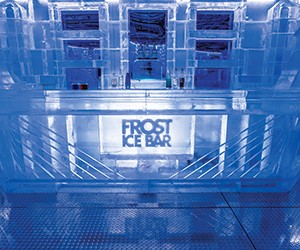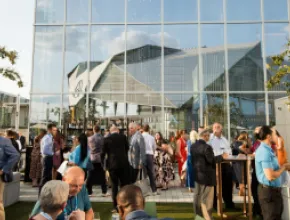With a distinctive identity overflowing in revolutionary history, New England character and city pride, it’s easy to feel a special bond with Boston in almost no time. "America’s Favorite City" has so much to offer in terms of culture, entertainment and meetings infrastructure, it is surprising to realize the city itself is only the 20th largest in the country.
Yet with its low-rise neighborhoods, quaint brick buildings and intimate streets, downtown Boston is at once inviting and unintimidating, especially compared to other prominent East Coast cities.
Beyond the city, American history extends well into the countryside, but you only need travel a short distance to access major draws like Cambridge’s Harvard and MIT, the picturesque shorelines to the north or the inviting communities of Merrimack Valley.
Boston
Though its residents are known for their city pride, Boston doesn’t really need to sell itself. Fascinating history seems to wait around every corner, and visitors return home with cameras full of gas lamp-lit streetscapes in Beacon Hill, dozens of Revolutionary War-era colonial buildings, idyllic scenes of the park at Boston Commons and the mandatory snapshot of the Cheers bar. And don’t forget baseball, of course.
"Taking in a baseball game at Fenway Park, America’s most beloved ballpark, always ranks as No. 1 on delegates’ and meeting planners’ lists," says Patrick B. Moscaritolo, president and CEO of the Greater Boston CVB. "And why not, since it’s a unique ballpark a short walk away from the Hynes Convention Center and 4,000 hotel rooms in the Back Bay."
While history buffs may feel as giddy as a kid in a candy store here, there are major draws for almost every sort of enthusiast. Newbury Street’s shopping scene in upscale Back Bay has become comparable to Rodeo Drive, and its restaurants top the charts as well. The city’s North End draws visitors and locals alike for its well-preserved Italian culture and cuisine. And the walkable downtown packs together history galore with its world-renowned parks, beautiful waterfront and adjacent Chinatown.
It is these mainstays that draw more than 16 million visitors annually, but when they are coupled with Boston’s significant investment in modern meetings infrastructure, the city becomes an ideal destination for planners.
"As a result of our $15 billion underground transportation system from Logan International Airport, delegates can be in the city to hotels and convention centers within minutes," says Beth Stehley, vice president of sales and convention services. "And our largest and newest convention center in the Seaport District [the Boston Exhibition and Convention Center] is 10 minutes from the airport, with its own tunnel exit."
Boston was large enough to absorb nearly 30,000 room nights in April, when it hosted the 2010 Symposium & Congress of the American Society of Cataract and Refractive Surgery and American Society of Ophthalmic Administrators. But while finding oversized name cards may have been a challenge for Paula K. Schneider, director of meetings and conventions for the two associations, finding event space was not.
"The city, in addition to its rich history, has so much to offer the meeting attendee," she says. "In addition to the educational conference, the society also hosted a number of events at different venues throughout the city. The events were in unique locations, and the attendees were very pleased with the venues, transportation and food and beverage."
In terms of meetings infrastructure, Boston offers far more than its size would imply. For the major gatherings, there is the 1.3 million-square-foot Boston Convention and Exhibition Center, with 516,000 square feet of continuous exhibit space and 84 meeting rooms; the John B. Hynes Veterans Memorial Convention Center, with 176,000 square feet of space, a 24,000-square-foot ballroom and 41 meeting rooms; and the Seaport World Trade Center, featuring a 118,000-square-foot exhibit hall, 200,000 square feet of meeting space and a 396-seat amphitheatre. The Hynes Center features a brand-new fine dining restaurant, Georges Bank, with private dining space for 80 people.
Upscale meetings will find plenty of hospitality in Boston, home to a wide range of luxury hotels. The regal Taj Boston is a favorite, with an ideal park-front location, stately guest rooms dating back to 1927, more than 18,000 square feet of function space and its well-known rooftop function room, offering panoramic city views. Nearby in the Financial District, the Langham Boston is another standout property, holding court in the elegant former Federal Reserve Bank building. On Beacon Hill, the Liberty Hotel is an imaginative luxury property housed in the former Charles Street Jail.
In contrast to these historic properties, the 150-room Fairmont Battery Wharf Hotel on Boston’s waterfront and the 148-room Mandarin Oriental in the Back Bay are each just 2 years old.
Larger groups will have breathing room at the 793-room Westin Boston Waterfront, connected to the Boston Convention and Exhibition Center, or the 471-room Renaissance Boston Waterfront Hotel. Another top choice on the waterfront is the 424-room InterContinental Boston, with 32,000 square feet of meeting space. Additional meetings hotels include the Boston Park Plaza, Hilton Boston Back Bay, Boston Marriott Copley Place, Fairmont Copley Plaza, Sheraton Boston and Westin Copley Place. Recently joining the collection are the 114-room Ames Hotel (Morgan Hotel Group) and the 234-room W Boston Theatre District Hotel.
Completion of the New Rose Kennedy Greenway, formerly known as the "Big Dig," has made a major impact on the accessibility and beautification of the city’s waterfront, offering 15 acres of manicured parks. Additionally, the new 44-mile Boston HarborWalk is finished. The new harbor-front Northern Avenue Liberty Wharf development is slated to open on the HarborWalk within the next month. The $60 million, three-building complex will include four restaurants.
Cambridge
Home to two of the world’s most prestigious universities—Harvard and MIT—the small city of Cambridge could easily boast the highest concentration of sharpened brains in the U.S. Located just across the Charles River from Boston’s Back Bay neighborhood and well-linked with the city’s subway system, Cambridge feels more like a neighborhood of Boston than a separate city. Its academic base gives it a lively nightlife, yet this is balanced by several renowned museums and galleries, ideal for small events.
As far as meetings, Cambridge makes it easy on planners, with its Cambridge Conference Collection, a group of eight meeting hotels within a two-mile radius. The collection brings together more than 102,000 square feet of meeting space and 3,500 guest rooms at the Hyatt Regency Cambridge Sheraton Commander (which recently finished a $15 million renovation), Doubletree Guest Suites, Hotel Marlowe, Le Meridien Cambridge, Marriott Cambridge Center, Royal Sonesta Hotel and Charles Hotel. The city’s newest addition, Hotel Veritas, brings an additional 31 upscale guest rooms.
Beyond Boston
While Boston’s charms are irresistible, planners should remember that there is a small world to be explored just outside the city limits. Recreation, seafood and quaint communities are the big draws north of the city in Essex County, with similar appeal to the northwest in Merrimack Valley.
Both offer considerable meetings options, such as the Sheraton Colonial Boston North Hotel & Conference Center in Wakefield, the Wylie Inn & Conference Center in Beverly and the Wyndham Boston Andover. Meanwhile, the historic Andover Inn recently reopened after undergoing a multimillion-dollar renovation.
The 30,000-square-foot Tsongas Arena and the historic 20,000-square-foot Lowell Memorial Auditorium provide additional options for groups.
Hunter Holcombe is a die-hard West Coaster, but his favorite East Coast city is Boston.






